What is a Load Balancer in Cloud Computing?
Cloud computing delivers IT services in which resources, such as storage, processing, and applications, are made available across a network, often the Internet, on a pay-as-you-go basis. It allows users to access and use shared resources, such as servers, storage, and applications, over the Internet. This eliminates the need for organizations to invest in and maintain their own IT infrastructure, which can be costly and time-consuming. Cloud computing services are typically provided by third-party companies, such as AWS, Azure, and Google Cloud Platform (GCP). There are mainly three types of cloud computing service models: Infrastructure-as-a-service (Iaas), Platform-as-a-service (Paas), and Software-as-a-service (Saas).

Load Balancer in the Cloud Computing
A load balancer service’s responsibility in cloud computing is to make sure that no server gets overworked with numerous requests. To achieve this, it essentially splits up incoming network traffic among several servers, improving resource utilization, failover capabilities, and performance. It frequently sends traffic to the most capable servers. As Internet traffic continues to increase at a rate of approximately 100 % each year, the current volume of Internet traffic is expected to more than double within the next few years.
As a result, the server’s workload is increasing rapidly, leading to server overload, especially for popular web servers. There are two basic solutions to the issue of servers being overloaded:
1.Single-server solution: A single-server solution is a type of load balancer that is implemented on a single server. It is typically used for small to medium-sized applications or websites that don’t require high traffic or scalability. The single-server load balancer distributes incoming network traffic across multiple server instances, which can help to improve performance and reliability.
2. Multiple-server solution: A multiple-server load balancer implemented across multiple servers. This type of load balancer is typically used for large-scale applications or websites that require high traffic and scalability. It distributes incoming network traffic across multiple servers, which can help to improve performance, availability, and reliability.
Two types of Load Balancers
1.Software-based load balancer: Software-based load balancers are compatible with common hardware (desktops, PCs) and software platforms.
2. Hardware-based load balancer: Hardware-based load balancers are customized containers containing Application Specific Integrated Circuits (ASICs) designed for a specific function.
Hardware vs. Software Load Balancer
Traditional load-balancing systems depend on specialized technology housed in a data center and necessitate a team of skilled IT professionals to set up, configure, and maintain the system. Only major corporations with substantial IT budgets can profit from enhanced performance and dependability. In the era of cloud computing, hardware-based systems have an additional significant disadvantage: they do not support cloud load balancing, as cloud infrastructure providers often do not let a client or proprietary hardware in their environment.
However, software-based load balancers can give the reliability and performance advantages of hardware-based solutions at a far lower price. Because they operate on existing hardware, even smaller businesses may afford them. In addition, they are suitable for cloud load balancing because they may operate in the cloud like any other software.
Examples of Cloud Load Balancers Services
Multiple cloud providers, including the three major platforms, offer load-balancing services.
1.AWS elastic load balancer (ELB): A cloud-based load balancer provided by AWS. It supports application load balancer (ALB) and network load balancer (NLB) and can be easily integrated with other AWS services.
2. Azure load balancer: It is provided by Microsoft Azure. It supports layer 4 and layer 7 load balancing and can be easily integrated with other Azure services.
3. Google Cloud load balancer: It is provided by Google. It supports layer 4 and layer 7 load balancing and can be easily integrated with other GCP services.
4. HAProxy: An open-source software-based load balancer that supports layer 4 and layer 7 load balancing. It is widely used for high-traffic websites and has a reputation for being fast, reliable, and easy to configure.
5. Nginx: An open-source web server that also includes load-balancing capabilities. It is used as a reverse proxy and load balancer for HTTP and TCP/UDP traffic.
6. F5 Big-IP: A hardware-based virtual appliance load balancer that supports both layer 4 and layer 7 load balancing. It is often used in enterprise environments and offers various advanced features, such as SSL offloading and content-based routing.
Cloud Computing with InfosecTrain
As the world moves toward cloud computing, it is not only a wise option for businesses but is increasingly a requirement. Cloud computing is virtually universally acknowledged as an inevitable development in the information technology industry. With the aid of the Internet, cloud computing enables customers to access various computer services on demand.
If you intend to begin a cloud computing career and are unsure of how to do it, we have the information you need. Check out the Cloud Computing Certification Training courses offered by InfosecTrain to advance your career in cloud computing.



 1800-843-7890 (India)
1800-843-7890 (India) 
